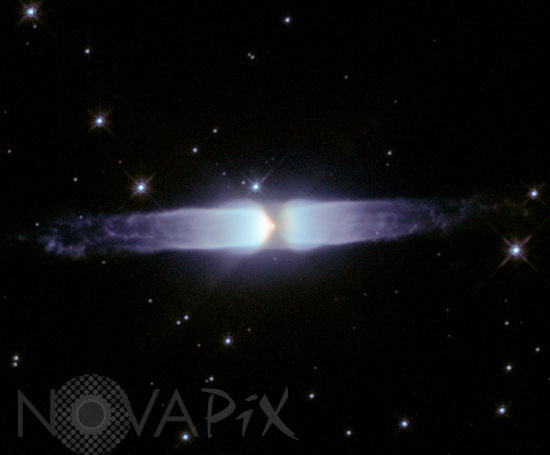Photo Agency - Astronomy - Space - Nature

Young planetary nebula Henize 3-401
author: ESA/Novapix
reference: a-nep98-90001
Image Size 300 DPI: 12 * 10 cm
This image, taken with the NASA/ESA Hubble Space Telescope, shows the young planetary nebula Henize 3-401. Hubble's extraordinary vision reveals that it is one of the most elongated planetary nebulae found so far. The image shows two very long cylindrical outflows with intricate thread-like structures and tattered ends. In this image, we are seeing the central star responsible for the beautiful display in the nebula for the first time. Although planetary nebulae exist in many different shapes they are often elongated, or as astronomers call it, 'bipolar'. Although astronomers agree on the terminology, they disagree on how these nebulae become so elongated. Some claim that a second star, a companion orbiting around the central star, is needed to create the jet-like streamers of gas. Others think that strong magnetic fields are capable of funnelling the gas into the long outflows. Henize 3-401 is an interesting astronomical object since astronomers can peer directly into the brew of different elements created in the witch's cauldron that is a star's core. During this brew, stars form complex organic molecules that may be some of the molecular building blocks of life. Henize 3-401 is currently passing through a phase that is very short, in astronomical terms, and there are not very many similar objects around for similar study. It will take only a few thousand years for the central star to exhaust its nuclear fuel and become a cooling, fading white dwarf. Henize 3-401 is located in the constellation of Carina (the Keel) at an approximate distance of 10 000 light-years. This picture is composed of three exposures obtained with Hubble's Wide Field Planetary Camera 2 on 12 June 1997. The three exposures were taken through a wide orange filter (1200 seconds) shown in blue, a hydrogen-alpha filter (400 seconds) shown in red, and a singly ionised sulphur filter (1200 seconds) shown in green.
Contact : Stéphane Aubin +33-(0)9-51-26-53-76
© Novapix - All rights reserved


